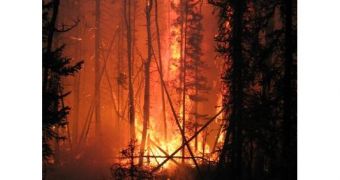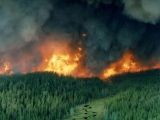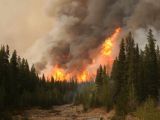A new study carried out by Canadian and US researchers, concluded that climate change actually causes wildfires to burn more intensely, thus releasing more greenhouse gases into the atmosphere and speeding up the process.
The research focused on northern wildfires and Jennifer Harden, a US Geological Survey scientist and co-author of the study, believes the results add to the growing evidence that the ecosystems in the northern hemisphere are the most affected by the global warming.
“This includes longer snow-free seasons, changes in vegetation, loss of ice and permafrost, and now fire, which is shifting these systems from a global carbon sink toward a carbon source,” she dded.
The researchers examined almost 200 forest and peatland sites, not long after the wildfires were extinguished, in order to measure the amount of biomass that had been burned.
University of Guelph professor Merritt Turetsky, lead author of the study, said that “we've been chasing fires in this region for a number of years, which is how we amassed this unique data set.
“When most people think of wildfires, they think about trees burning, but most of what fuels a boreal fire is plant litter, moss and organic matter in surface soils.
“These findings are worrisome because about half the world's soil carbon is locked in northern permafrost and peatland soils.
“This is carbon that has accumulated in ecosystems a little bit at a time for thousands of years, but is being released very rapidly through increased burning.”
The researchers' findings are very important for climate talks currently taking place in Mexico, the integrative biology professor added, as “essentially this could represent a runaway climate change scenario in which warming is leading to larger and more intense fires, releasing more greenhouse gases and resulting in more warming.
“This cycle can be broken for a number of reasons, but likely not without dramatic changes to the boreal forest as we currently know it.”
The researchers also examined fire records, starting with the 1950s, and concluded that “over the past 10 years, burned area has doubled in interior Alaska, mostly because of increased burning late in the fire season.
“This is the first study that has demonstrated that increases in burned area are clearly linked to increases in fire severity,” added co-author Eric Kasischke, a professor at the University of Maryland.
“This not only impacts carbon storage, but also will accelerate permafrost loss and changes in forest cover.”
Turetsky added that the high number of severe burning rises the amount of health problems, because fire emissions contain mercury and particulate matter that can cause respiratory difficulties.
“We are hoping people will recognize the seriousness of climate change for northern regions and people living in them.
“Wildfire is going to play a more and more important role in shaping the north.”
This is actually the first study to focus on the fires in the Alaskan interior – which is an area covering some 18.5 million hectares, and prove that they have become more serious in the past 10 years, and have released much more carbon into the atmosphere than was stored by the forests in the region, over the same period.
This study will be published in Nature Geosciences this week.

 14 DAY TRIAL //
14 DAY TRIAL // 

